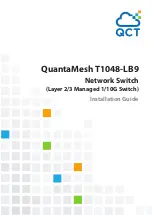
Raisecom
ISCOM2600G-HI (A) Series Configuration Guide
4 Ring network protection
Raisecom Proprietary and Confidential
Copyright © Raisecom Technology Co., Ltd.
200
detects a fault and switches the traffic. And the other end does not detect the fault and
switch traffic. Therefore, both ends may receive the traffic through different lines.
Bidirectional switching: when a line fails, even in one direction, both ends communicate
through APS protocol to switch traffic to the protection line. Therefore, both ends receive
and send the traffic through the same line.
This ISCOM2600G-HI series switch does not distinguish one-way and bidirectional switching
until in 1+1 mode; only bidirectional switching is available in 1:1 mode.
ELPS provides two modes for fault detection:
Detecting fault over physical interface status: to get link fault quickly and switching in
time, available to neighboring devices.
Detecting fault over CC: available to one-way detection or multi-devices crossing
detection.
Prerequisite
Connect interfaces.
Configure physical parameters to make interfaces Up at the physical layer.
Create VLANs.
Add interfaces to VLANs.
Configure CFP detection among devices and make them as neighbors (for CFM
detection mode only).
4.2.3 Default configurations of ELPS
Default configurations of ELPS are as below.
Function
Default value
Protection group mode
Revertive mode
WTR timer
5min
Hold-off timer
0
Reporting ELPS failure information to network management system
Enable
Fault detection mode
Physical link
4.2.4 Creating ELPS pair
Enable the ELPS pair for the ISCOM2600G-HI series switch as below.
Step
Command
Description
1
Raisecom#config
Enter global configuration mode.
















































